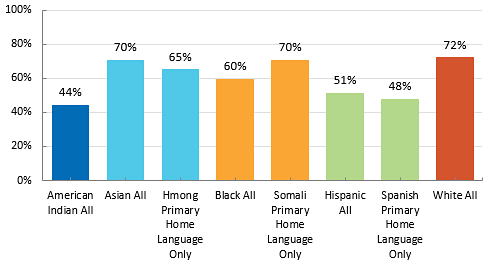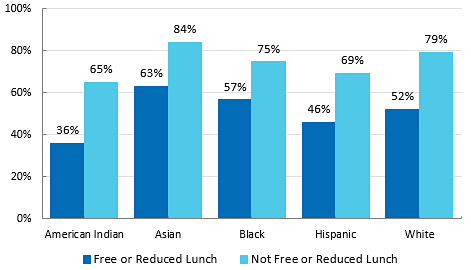Which High School Grads Go to College?
How many high school graduates enroll in college is a frequently asked question. Enrolling in college right after high school graduation is common and increasingly important since income on average increases with each level of education beyond high school.
In 2014, 69 percent of Minnesota's public high school graduating class of 2014 attended a postsecondary institution the following fall either in Minnesota or elsewhere.
- 50 percent enrolled in Minnesota
- 19 percent enrolled out of state
The rate includes students enrolling in Minnesota and out of state and at all types of colleges from vocational two-year to four-year. Minnesota's rate tracks with national trends.
Note: college enrollment rates leave out students not graduating from high school. Since there are large gaps in Minnesota public high school graduation rates by race/ethnic background even less students who are American Indian, Black and Hispanic attend college than their White and Asian younger aged peers.
Participation Rates by Race/Ethnicity and Primary Home Language Spoken
New data from the Minnesota Statewide Longitudinal Data System (SLEDS) allowed calculating the participation rates by primary home language spoken, free or reduced-price lunch enrollment and out-of-state enrollment of Minnesota's public high school graduates.
In general, White and Asian public high school graduates enrolled in college at rates higher than other populations. When calculating Minnesota high school student's race/ethnicity only compared to the three primary foreign languages spoken at home - Hmong, Somali and Spanish - variations occurred.
Percent College Enrollment by Race/Ethnicity and Primary Home Language Spoken
Minnesota public high school graduating class of 2014 enrolled in a Minnesota or out-of-state college in fall 2014

Source: Minnesota Statewide Longitudinal Data System
Nationally, immediate enrollment in college also varies by race and ethnicity. Of the 3 million high school graduates in 2013, 66 percent, enrolled in college the following fall. White student college enrollment (67 percent) was higher than the rate for those who were Black (57 percent). The national rate for those who were Hispanic (66 percent) was similar to White students. The immediate college enrollment rate for Asians (81 percent) was higher than the rates for Whites, Blacks, and Hispanics in 2013 and in each year since 2003.
Family Income Shows Large Differences in College Participation
College participation rates for high school graduates not receiving free or reduced-price lunch was 26 percent higher than students who received free or reduced-price lunch. Income of public high school graduates was measured by whether the student enrolled in free or reduced-price lunch at any time during high school.
Percent College Enrollment by Race/Ethnicity and Free or Reduced Priced Lunch Eligibility
Minnesota public high school graduating class of 2014 enrolled in a Minnesota or out-of-state college in fall 2014

Source: Minnesota Statewide Longitudinal Data System
College enrollment gaps by family income are also reported nationally. The college participation rate for high school graduates from high-income families (80 percent) was 31 percentage points higher than the rate for those from low-income families (49 percent).
Minnesota needs to break the cycle of lower-income students or students of color lower college participation rates. Minnesota's challenge moving forward is to successfully prepare and support underserved populations to certificate or degree completion while meeting future workforce demands in a period of changing demographics. Minnesota needs to increase access to degrees that open doors.
Note: documents in Portable Document Format (PDF) require Adobe Acrobat Reader 5.0 or higher to view.
Quick Links
- Why College?
- Explore Your Interests & Careers
- Prepare at School
- Summer Academic Enrichment Program
- The Many Ways to Earn Credit for College
- Recommended High School Classes & Graduation Requirements
- Advice for Students with Disabilities
- Succeed as an Adult Student
- Useful College Prep Resources
- Minnesota Goes to College!
- Collecting Data from Minnesota Postsecondary Institutions
- Campus Financial Aid Administrator Resources
- Campus Student Enrollment Reporting Resources
- Ordering Materials for Your Students
- Supplementing Your College Counseling
- Early Awareness Efforts
- Student Homelessness in Higher Education Resources
- Shared Library Resources
- MN FAFSA Tracker
- Campus Sexual Violence Prevention and Response
- Statewide FAFSA Filing Goal
- MyHigherEd
- Online Applications
- About Financial Aid
- What Does College Cost?
- Tips for Lowering the Cost of Higher Education
- Institutional Payments
- Financial Aid You Don't Repay
- Financial Aid You Must Repay (Student Loans)
- Financial Aid You Earn
- Military Service Education Benefits
- Reduced Out-of-State Tuition Options
- Education Tax Benefits
- Public Service Loan Forgiveness
- Ready, Set, FAFSA!
- North Star Promise
- Minnesota Paramedic Scholarship
- Data Maps and Infographics
- Educational Attainment Goal 2025
- Minnesota P-20 Statewide Longitudinal Education Data System
- Minnesota Measures
- Student Enrollment Data
- College Readiness & Participation Data
- Degrees, Graduation Rates, Attainment & Outcomes
- Tuition & Fees Data
- Student Health and Safety
- Financial Aid Data & Trends
- Institution and Data Search
- Transfer Students
- Research Reports
- A-Z Data Table Index
- Postsecondary Funding
- Special Student Populations
